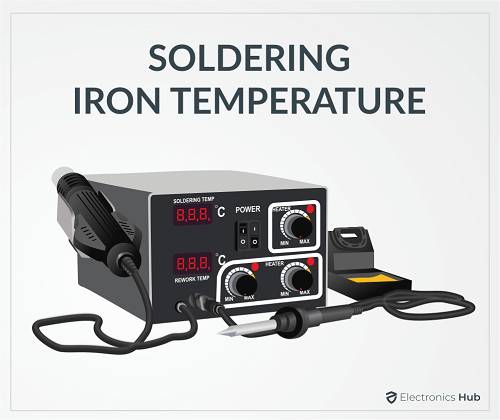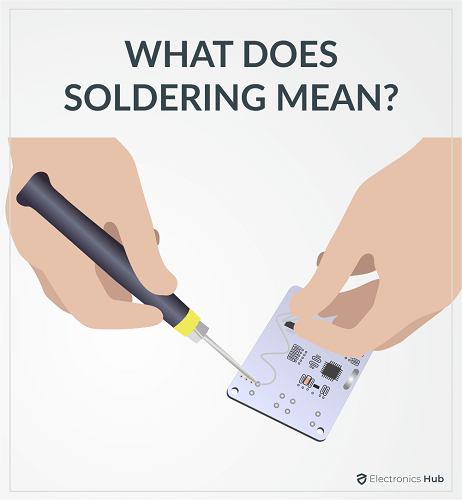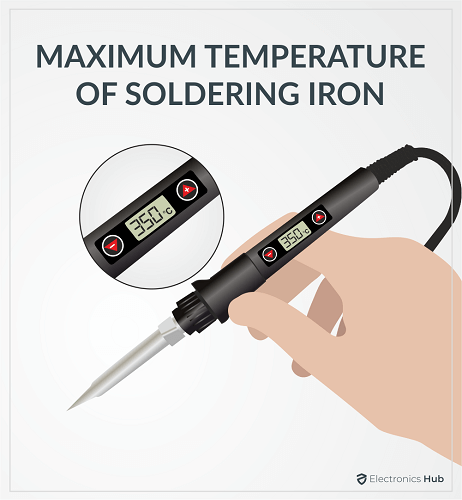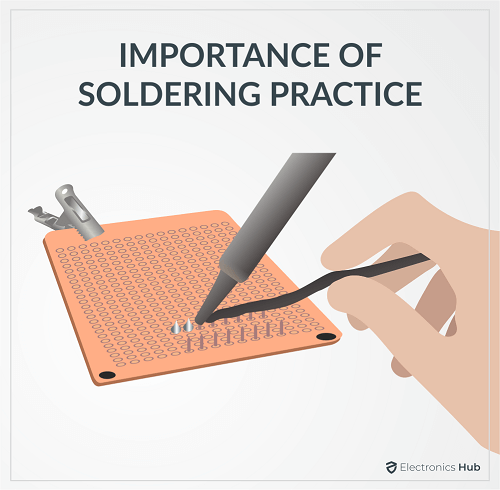A soldering iron is a hand-held device used to melt the solder (filler material) and join two metals. It is shaped in the form of a pen and uses a metal tip to heat the solder. If you are a beginner, a soldering iron is the best equipment to heat the solder for assembling electronic components on a PCB. It is lightweight and easy to hold. This increases the precision when you are applying heat over the solder.
But before choosing a soldering iron, you need to check the melting point of the solder. You need to choose a soldering iron that can generate a higher temperature than the melting point of the solder. Only then, you will be able to melt the solder and join the two metals. For instance, solder made of copper has a melting point of 1,0850C. Then, you should get a soldering iron that can generate heat in excess of 1,0850C.
The maximum heat soldering irons can generate depends on the specific models. Some models can generate heat up to 1,4000C. Contrarily, some models can only generate heat up to 4500C. Some models also come with variable temperature settings. You can set the maximum temperature depending on the melting point of the solder.
The following article explains the maximum temperature of a soldering iron and how to choose one with the right temperature based on your solder alloy.
Outline
Toggle- What Does Soldering Mean?
- What is the Maximum Temperature of a Soldering Iron?
- Temperature Range of Soldering Irons
- Choosing a Soldering Iron with the Right Temperature
- Measurement of Soldering Iron Temperature
- Factors Affecting Soldering Iron Temperature
- Importance of Soldering Practice
- Frequently Asked Questions
- Conclusion
What Does Soldering Mean?
Soldering is the process of joining two metals together by melting solder (filler material). In the soldering process, we do not melt the metals. Rather, we melt the solder which fuses with the two metals and holds them together. One of the main applications of soldering is assembling of electronic components on printed circuit boards (PCBs). Additionally, we can also use soldering to fix disjoint wires, electrical circuits, copper pipes, jewelry, and practically any two metals.
The solder is a metal alloy that is usually made of tin and lead. It is important the melting point of solder is lower than the melting point of the metals. Only then, the solder will melt first and fuse the metals.
To achieve soldering, you have to heat a soldering iron to poke the solder using its tip until the solder melts. Once it melts, you can join the two metals.
What is the Maximum Temperature of a Soldering Iron?
The maximum temperature of a soldering iron varies greatly depending on the model. As mentioned already, some soldering irons can get as hot as 1400°C. But, whereas, other models can only get as hot as 450°C.
While choosing a soldering iron, you have to consider the melting point of the solder. The soldering iron should be able to become hot enough to melt the solder.
Some soldering irons come with variable temperature settings. Using this setting, you can change the temperature of the soldering iron to suit the melting point of alloys.
Temperature Range of Soldering Irons
Temperature control mechanisms play a vital role in regulating the heat output of soldering irons. These mechanisms ensure precise temperature settings, allowing users to adjust the heat according to the specific requirements of their soldering project.
Furthermore, modern soldering irons often feature digital temperature control systems, offering greater accuracy and consistency in maintaining desired heat levels. Analog temperature control mechanisms, although less precise, are still widely used in traditional soldering irons.
Several factors influence the temperature range of soldering irons. The wattage rating of the soldering iron determines its power output, directly impacting the maximum temperature it can reach. Higher wattage irons can achieve higher temperatures, making them suitable for more demanding soldering tasks.
Additionally, the size and material of the soldering iron tip influence its heat conductivity and retention. A larger tip may require more power to maintain temperature, while different tip materials can affect heat transfer efficiency.
Soldering tasks require different temperature ranges depending on the materials being joined and the soldering technique employed.
- For soldering delicate electronic components, we use low temperature soldering, typically below 400°C (752°F), without risking damage from excessive heat. This range is ideal for soldering circuit boards and other electronic assemblies.
- For soldering wires, connectors, and small metal parts, medium temperature soldering, ranging from 400°C to 500°C (752°F to 932°F), is common.
- High temperature soldering involves temperatures above 500°C (932°F) and is suitable for heavy-duty soldering tasks such as plumbing, metalwork, and stained-glass assembly. These higher temperatures ensure proper bonding of materials with higher melting points.
Choosing a Soldering Iron with the Right Temperature

Besides, you also have to consider the effect of the iron and the size of the tip. Soldering irons that are high-effect and have a large tip consume less power to melt the solder.
For instance, a high-effect soldering iron with a large tip takes only 2500C to melt an alloy that has a melting point of 1900C. But, to melt the same alloy, a low effect iron with a small tip will take a temperature of 4000C.
Measurement of Soldering Iron Temperature
Two common methods for temperature measurement are thermocouples and thermistors. Thermocouples consist of two dissimilar metal wires that generate a voltage proportional to the temperature difference between their junctions. Thermistors, on the other hand, are temperature-sensitive resistors whose resistance changes with temperature.
Digital and analog temperature displays are the two primary types of temperature indicators found on soldering irons. Digital displays provide precise numerical readouts of the temperature, offering users greater control and accuracy. In contrast, analog displays use visual indicators such as a dial or scale to approximate the temperature, which may be less precise but are still effective in many applications.
Accuracy and calibration are crucial aspects of soldering iron temperature measurement. Calibration ensures that the temperature readings are correct and consistent, preventing errors in soldering due to inaccurate temperature settings. Regular calibration of soldering irons is necessary to maintain their accuracy over time, as factors like wear and drift can affect temperature readings. Calibration procedures typically involve comparing the measured temperature of the soldering iron to a known reference temperature and making adjustments as needed to ensure accuracy.
Factors Affecting Soldering Iron Temperature
Several factors influence the temperature output of a soldering iron, impacting its effectiveness in soldering tasks.
1. Wattage and Power Supply
One critical factor is the wattage of the soldering iron and the power supply it receives. Wattage determines the heating capacity of the iron, with higher wattage irons capable of reaching and maintaining higher temperatures. Adequate power supply is essential to ensure consistent heat output, especially for demanding soldering applications requiring high temperatures.
The wattage of a soldering iron directly relates to its heating capacity. Higher wattage irons deliver more power, allowing them to reach and maintain higher temperatures. This is particularly important for larger soldering projects or those involving heat-resistant components. Conversely, lower wattage irons are suitable for smaller, more delicate components that can be damaged by excessive heat.
Adequate power supply is essential to ensure consistent heat output, especially for demanding soldering applications requiring high temperatures. Battery-powered soldering irons, for instance, typically have lower wattages and may struggle to maintain consistent temperatures during extended use.
2. Tip Size and Material
The size and material of the soldering iron tip significantly impact heat transfer. The tip size determines the surface area in contact with the solder joint, influencing heat transfer efficiency. Larger tips, due to their greater mass, require higher temperatures to achieve the same level of heat transfer compared to smaller tips.
Additionally, the tip material plays a role. Copper tips, for example, offer excellent heat conductivity, meaning they heat up quickly and transfer heat efficiently to the solder joint. In contrast, tips made from other materials like iron may require a higher temperature setting to compensate for their lower thermal conductivity.
3. Environmental Factors
Believe it or not, even the surrounding environment can influence your soldering iron’s temperature. Airflow, for instance, can affect heat dissipation. Working in a drafty environment can cause the tip to cool down more rapidly, requiring you to adjust the temperature setting accordingly. Similarly, ambient temperature can impact the overall heat transfer dynamics, with colder temperatures requiring higher power settings to achieve desired soldering temperatures. Proper ventilation and workspace temperature control are essential to minimize the effects of environmental factors on soldering iron performance.
Importance of Soldering Practice
Soldering requires a certain level of skill to melt the solder and join the two metals perfectly. But, unlike other processes such as welding, it is easier to master the art of soldering.
The important thing is to keep practicing until you can do it flawlessly. If you are using a soldering iron with variable temperature settings, you may find it difficult to set the correct temperature in the beginning. But with continued usage, you will be able to choose the perfect temperature for different solders.
You have to follow the trial and error method to gain proficiency in soldering. If you notice that the solder is not melting as fast as you thought, you will have to increase the temperature.
Contrarily if the solder melts faster, you have to decrease the temperature a bit.
Frequently Asked Questions
A soldering iron is a hand-held device that melts the solder alloy and joins two metals. They run on an electric supply and generate heat higher than the melting point of the solder alloy.
Instead of a soldering iron, you can use screwdrivers, Alan wrenches, steel wires, and nails. But, unless you are proficient and have experience in soldering, we highly recommend you to use a soldering iron.
Lead has a low melting and is one of the commonly used ingredients in solder. While melting the solder, it releases lead fumes. Lead can lead to serious chronic health effects and cause nerve disorders, muscle pain, reproductive and digestive problems.
Yes, we highly recommend you wear a mask while soldering. It can prevent the inhalation of lead and other toxic metals fumes that can cause significant distress to your body.
When you heat the solder, it can cause spitting. Your skin will get burnt by the hot solder or it will absorb the chemicals. Both are harmful to your skin. Wearing gloves will protect your skin from these harmful chemicals and hot solder.
Conclusion
To sum it up, your soldering iron should be able to become hot enough to melt the soldering alloy. If you will be using the same solder for multiple soldering purposes, you can choose a soldering iron that can become hot enough to melt it. If you will be using different alloys as solders, you can get an iron with a variable temperature setting. Besides, a high-effect soldering iron with a large tip can melt the solder in a lesser time than a low-effect iron with a small tip.
If you have any further queries or doubts, let us know using the comments section. Our team will help you out.




